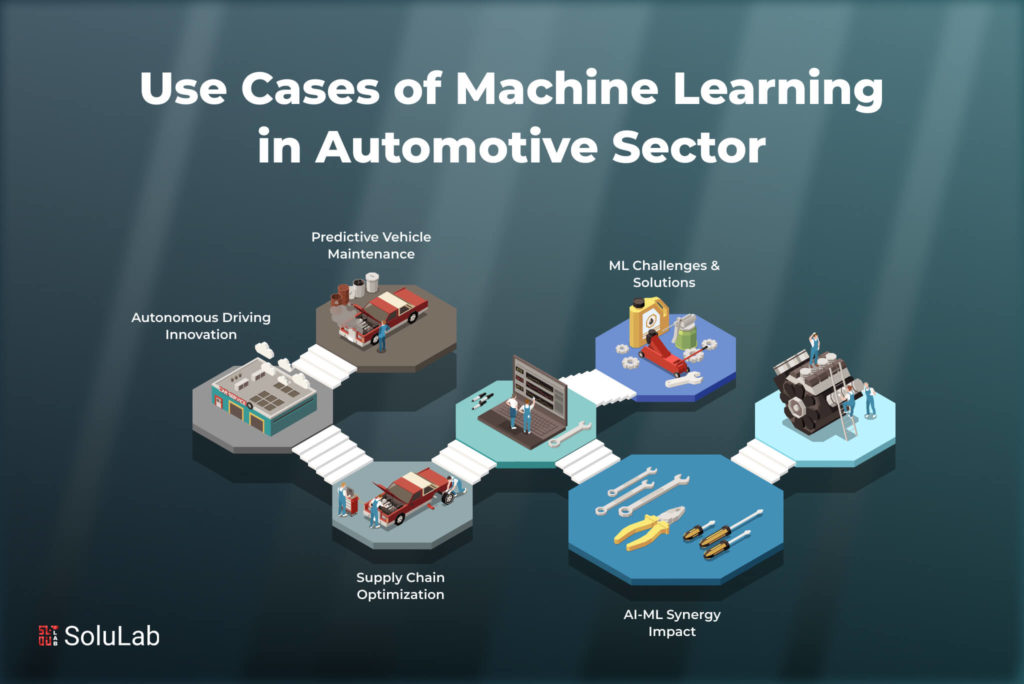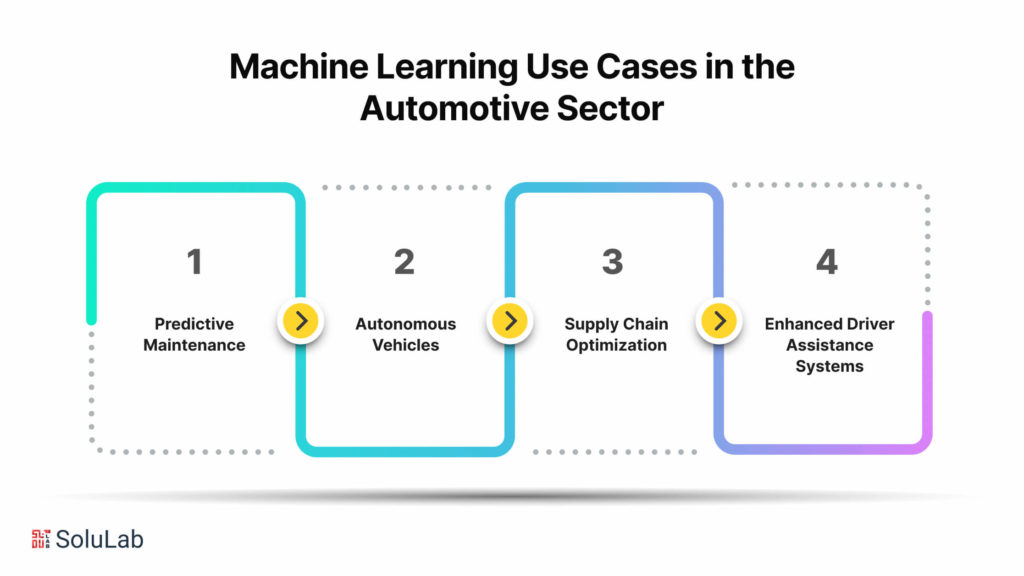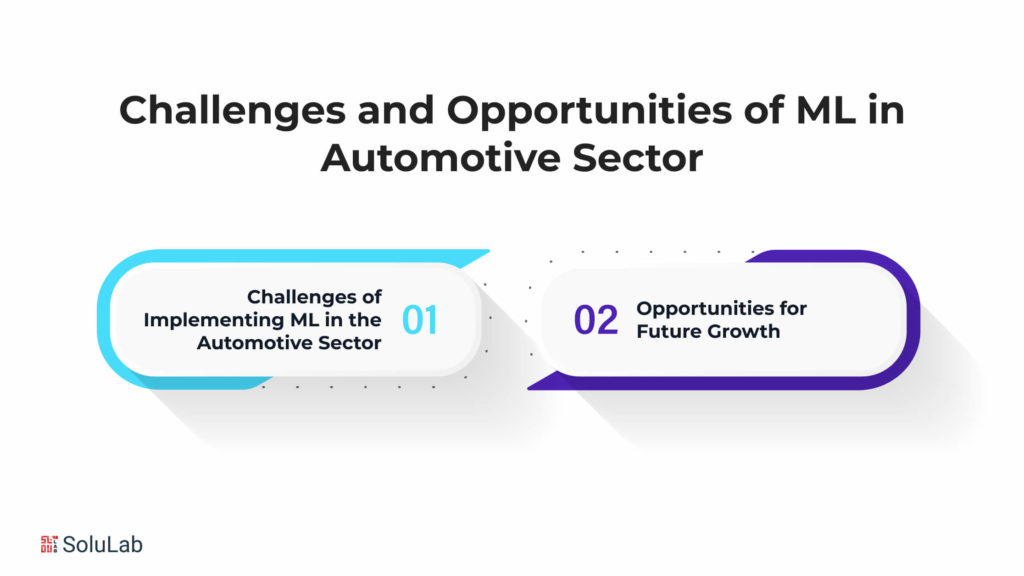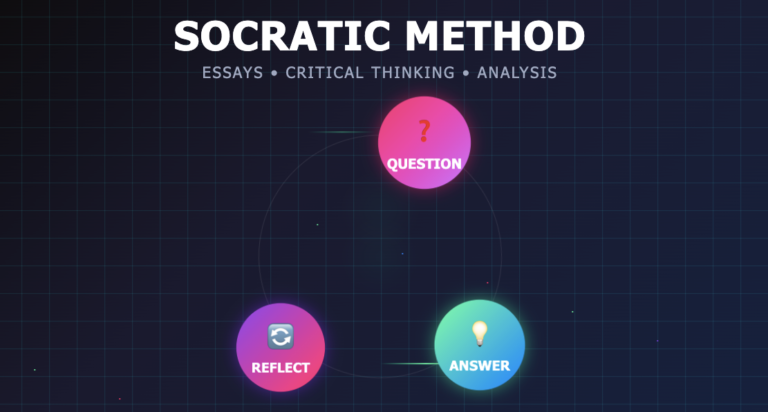
The integration of Machine Learning (ML) in the automotive industry has brought about significant advancements, reshaping transportation and creating a more connected, intelligent, and sustainable ecosystem. ML applications span various areas, including predictive maintenance, autonomous vehicles, advanced driver assistance systems, vehicle connectivity, infotainment, manufacturing, and supply chain optimization. Predictive maintenance identifies potential vehicle failures, reducing downtime. Autonomous vehicles utilize ML for perception, decision-making, and navigation, improving through data learning. ADAS leverages ML for real-time assistance, enhancing safety and comfort. ML personalizes the in-vehicle experience, tailoring recommendations and enabling improved traffic management. It optimizes manufacturing and supply chains by identifying inefficiencies, reducing waste, and aligning production with demand.
Machine Learning Use Cases in the Automotive Sector

Automotive machine learning leads the way to revolutionize the automotive industry. Discover a range of applications where sophisticated algorithms are reshaping the sector, boosting safety, improving efficiency, and elevating driving experiences.
Predictive Maintenance:
Leveraging machine learning algorithms, predictive maintenance has revolutionized vehicle maintenance by proactively identifying potential issues before they become costly breakdowns. This shift from reactive to predictive maintenance maximizes vehicle uptime and reduces operational costs associated with repairs and replacements. Machine learning algorithms analyze vast amounts of data from embedded sensors to recognize patterns and anomalies indicative of potential issues. Utilizing historical data, real-time telemetry, and contextual factors, these algorithms accurately predict when a component or system is likely to fail.
Armed with these predictions, manufacturers can proactively schedule maintenance interventions, minimizing downtime and inconvenience for vehicle owners while optimizing resource allocation for maintenance teams. Predictive maintenance powered by automotive machine learning represents a significant advancement in the automotive industry, enhancing reliability and safety while reducing overall ownership costs for customers.
Autonomous Vehicles:
Automotive machine learning (ML) plays a pivotal role in the development of self-driving cars, enabling them to perceive and respond to their environment. Sensors generate vast amounts of data, which ML algorithms analyze to make informed decisions and navigate complex traffic situations. Through supervised and unsupervised learning, algorithms are trained using diverse datasets to enhance their robustness and accuracy. ML also optimizes vehicle performance, energy efficiency, and passenger comfort by analyzing data, identifying energy-saving opportunities, and predicting maintenance needs. With ML algorithms continuously improving, self-driving cars have the potential to revolutionize the automotive industry and transform transportation.
Supply Chain Optimization:
Machine learning (ML) algorithms are revolutionizing supply chain processes in the automotive industry, leading to increased efficiency and cost savings. Predictive analytics, a key application of AI, optimizes inventory management by forecasting demand for specific components, and minimizing stockouts and production delays. ML algorithms analyze vast data from various sources, identifying potential disruptions and enabling informed decision-making. Integrating ML into supply chain processes offers several benefits, including improved efficiency, reduced costs, and enhanced agility. As the automotive industry evolves, ML algorithms will play a crucial role in driving supply chain excellence, providing a competitive advantage and exceptional customer experiences.
Enhanced Driver Assistance Systems (ADAS):
Machine Learning in automotive industry (ML) plays a pivotal role in advancing Enhanced Driver Assistance Systems (ADAS) by enabling real-time analysis of vast sensor and camera data. ADAS leverages ML algorithms to process data swiftly and accurately, facilitating sophisticated features that enhance driving safety and convenience. Key ML-enabled features in ADAS include lane-keeping assistance, collision avoidance, and adaptive cruise control. Lane-keeping assistance uses computer vision algorithms to monitor lane boundaries and provide alerts when drifting occurs, preventing unintentional departures.
Collision avoidance systems employ advanced ML algorithms to detect potential hazards and take evasive actions, reducing the risk of accidents. Adaptive cruise control utilizes sensor data and environmental information to maintain a safe following distance and adjust speed accordingly, enhancing comfort and safety on highways. ML’s computational intelligence is the driving force behind ADAS, enabling the analysis of sensor data and the derivation of meaningful insights. These insights support drivers, making the driving experience safer, more efficient, and more enjoyable. As ML continues to evolve, we can expect even more advanced ADAS capabilities, leading to a future of autonomous driving.
Machine Learning in the Automotive Industry
In where Machine Learning in automotive industry converges, we undertake a journey to explore the groundbreaking applications and advancements that are transforming the automotive industry. From the awe-inspiring vision of autonomous driving to the practical benefits of predictive maintenance, automotive machine learning is playing a pivotal role in shaping the future of transportation.
AI and ML Integration:
The harmonious interplay between Artificial Intelligence (AI) and Machine Learning (ML) is revolutionizing the automotive industry. AI-driven applications empower vehicles to learn, adapt, and make real-time decisions, resulting in safer, more efficient, and personalized driving experiences. AI algorithms process vast amounts of sensor data to enhance road safety, predict traffic patterns, and make split-second decisions. Vehicles continuously learn, adapt to diverse scenarios, and optimize performance in various conditions.
The synergy between AI and ML in automotive industry enables the development of autonomous vehicles that navigate without human intervention. These vehicles use data from multiple sensors to create a comprehensive understanding of their environment and make informed decisions for a safe journey. AI and ML in automotive industry also contribute to optimizing vehicle performance. By analyzing data on fuel consumption, emissions, and driving behavior, AI algorithms identify areas for improvement and implement adjustments to enhance efficiency. Predictive maintenance detects potential issues before they become major problems, reducing downtime and maintenance costs. The integration of AI and ML in automotive industry in the automotive industry is transforming the automotive landscape into a new era of innovation and progress.
Challenges and Opportunities

In automotive machine learning implementation, a journey of exploration awaits. Delve into the intricate challenges that arise, spanning from data privacy concerns to regulatory complexities. Simultaneously, uncover the boundless opportunities that await, heralding a transformative era in our perception and interaction with vehicles.
Challenges of Implementing ML in the Automotive Sector:
The implementation of Machine Learning in automotive industry (ML) solutions faces challenges related to data privacy, technological limitations, and regulatory hurdles. Data privacy concerns arise from the need to securely handle sensitive information, especially in industries like healthcare, finance, and government. Technological limitations include issues with data quality and computational complexity. Regulatory hurdles involve complying with data protection regulations like GDPR. To address these challenges, organizations should prioritize data security, work with legal experts, and collaborate with technology providers to leverage innovative solutions.
Opportunities for Future Growth:
The automotive industry, despite facing numerous challenges, recognizes the tremendous potential in the continued expansion of Machine Learning in automotive industry (ML) applications. This industry is on the cusp of a transformative era, driven by cutting-edge trends like edge computing and federated learning. These emerging paradigms are unlocking new frontiers for innovation and fostering unprecedented opportunities for collaboration.
Edge computing, by bringing computational capabilities closer to the source of data, enables real-time processing and analysis, which is crucial for autonomous vehicles and advanced driver assistance systems. This decentralized approach reduces latency, improves response times, and enhances overall safety. Moreover, federated learning, a decentralized ML technique, allows for collaborative training of models across multiple devices without compromising data privacy. This breakthrough empowers automakers to leverage vast amounts of data collectively, accelerating the development of more accurate and robust ML models.
The convergence of these trends is driving a paradigm shift in the automotive industry. Automakers are now able to harness the power of ML to create vehicles that are not only safer and more efficient but also highly personalized and connected. From predictive maintenance to intelligent navigation systems, ML is transforming every aspect of the driving experience.
However, the path forward is not without challenges. The automotive industry must address issues related to data security, regulatory compliance, and ethical considerations to ensure the responsible and sustainable adoption of ML. Collaboration between industry players, policymakers, and academia will be crucial in shaping a future where ML-driven vehicles enhance our lives while upholding the highest standards of safety and privacy. the automotive industry is poised for remarkable growth in ML applications, driven by emerging trends such as edge computing and federated learning. By embracing these transformative technologies, automakers can unlock new avenues for innovation, enhance vehicle performance, and create a more connected and intelligent driving experience.
Conclusion
The integration of machine learning (ML) in the automotive sector is revolutionizing the industry by offering innovative solutions to long-standing challenges. SoluLab, as a leading ML development company, is committed to providing top-notch ML development services. With a skilled team of machine learning developers, SoluLab offers tailored solutions that leverage the potential of ML for enhanced efficiency and innovation in the automotive industry. By partnering with SoluLab, businesses can unlock opportunities in optimizing supply chains, implementing predictive maintenance strategies, and contributing to the development of intelligent vehicles. SoluLab is a trusted ally in the journey towards a technologically advanced and future-ready automotive landscape.
FAQs
1. How does machine learning contribute to predictive maintenance in the automotive industry?
Machine learning enables predictive maintenance by analyzing historical and real-time data from vehicles. Algorithms can predict potential issues, allowing for proactive maintenance, reducing downtime, and enhancing overall reliability.
2. What role does machine learning play in autonomous vehicles?
Machine learning is crucial for autonomous vehicles, providing the ability to analyze vast datasets from sensors and make real-time decisions. ML algorithms contribute to perception, decision-making, and control systems, making autonomous driving safer and more efficient.
3. How does machine learning optimize supply chain processes in the automotive sector?
Machine learning optimizes supply chain processes by analyzing data related to inventory levels, demand forecasting, and supplier performance. This allows for better inventory management, cost reduction, and improved overall efficiency in the automotive supply chain.
4. What are Enhanced Driver Assistance Systems (ADAS), and how does machine learning contribute to them?
Enhanced Driver Assistance Systems (ADAS) utilize machine learning to provide real-time analysis of data from sensors and cameras. ML algorithms enhance features such as lane-keeping assistance, collision avoidance, and adaptive cruise control, contributing to safer driving experiences.
5. What challenges are associated with implementing machine learning in the automotive sector?
Challenges include data privacy concerns, secure handling of sensitive information, technological limitations, and regulatory hurdles. Overcoming these challenges is crucial for the successful implementation of advanced machine learning algorithms.
6. How does the synergy between AI and ML impact the automotive industry?
The synergy between Artificial Intelligence (AI) and ML enhances decision-making processes, contributing to the development of intelligent vehicles. AI-driven applications in conjunction with Machine Learning in automotive industry enable vehicles to learn and adapt to diverse scenarios, driving innovation in the automotive industry.
7. What opportunities does the continued growth of machine learning in the automotive industry present?
The growth of machine learning in the automotive industry presents opportunities for innovation and collaboration. Emerging trends such as edge computing and federated learning open new avenues for the development of intelligent vehicles, predictive analytics, and efficient supply chain management.





